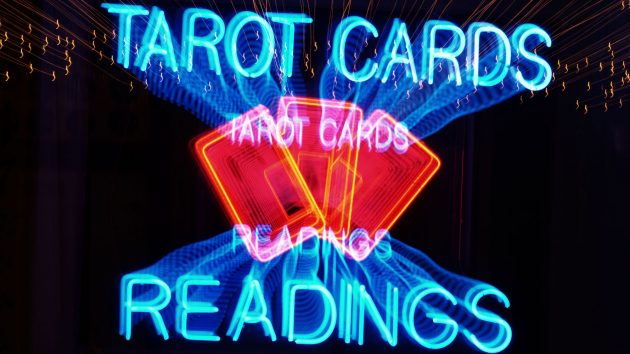How a tarot card reading changed my life - for the better


Daisy Waugh reports on the resurgence of tarot reading and reveals why she quit her job as a journalist to retrain to become a professional tarot reader.
Tarot readings have become fashionable. As a professional tarot reader, I can tell this by the sheer number of requests for readings I get these days. Six years ago, when I first discovered my love for the cards and began on the long journey of learning how to read them, I’d never have imagined how much attitudes would change.
Back then, I took a one-day course with the intention of writing about the tarot as a journalist. It was meant to be a bit of a laugh. But after that single day, I found I was hooked – captured by the beauty and structure of the cards and their uncanny wisdom. I could think and talk of nothing else. Friends thought I was losing my marbles and didn’t hesitate to tell me so.
Not so, any more. Now, they ask for readings. Now, I am invited to read the tarot at fat-cat corporate lunches! It’s wonderful for my bank balance (I won’t lie). More than that though, it’s wonderful that something with so much potential to help people is no longer looked on with the fear and ridicule it once was. People are discovering the comfort and clarity that the tarot can bring into their lives, and it’s being accepted into the mainstream. But tarot has been around for centuries. So why is it so popular now? People often suggest the upsurge in popularity here and in the US is in response to world news: the uncertainty of Brexit, the unpredictability of Trump and Putin, the melting ice caps and so on…

Of course, it’s no good pretending the western world is in a particularly happy or stable place right now. On the other hand, life on earth has never been safe, or stable or certain. What’s changed is our awareness of the world. Technological advances bring us 24-hour rolling news – a never-ending feed of the mayhem and wickedness taking place in distant corners of the globe. It’s bound to make us feel insecure.
Add to that, the other great gift of technology: efficiency. Our modern obsession with living life “to the full” has turned our action-packed lives into a whirlwind of grab and go, click and collect. We may get to the bottom of our to-do list more easily these days – except somehow the lists just keep growing. We may even have found time to make it to the gym three times a week, go paragliding in Paxos at the weekend and Instagram the experience to our followers – but where has it left us, really, except physically and financially exhausted?
In these frantic times and – in the West, with organised religion on the wane – when do we ever have time to reflect? Modern life sees to our worldly needs, but I think it leaves us feeling spiritually starved. Our busy lives are constantly luring us away from healthy, necessary contemplation. The tarot, in its mysterious wisdom, offers us a gateway back to our spiritual selves.
Sign up to our free daily email for the latest royal and entertainment news, interesting opinion, expert advice on styling and beauty trends, and no-nonsense guides to the health and wellness questions you want answered.
What are tarot cards?
No one is exactly sure where tarot cards originated, but the earliest decks come from mid-15th century northern Italy and were originally created as a card game. Tarot cards enjoyed a burst of popularity in the late 19th and early 20th century in the US and Europe.
A conventional tarot deck (there are many varieties) consists of 78 cards; each card represents an emotion, situation or a stage in the journey of life, and its meaning will alter depending on many things: above all, which other cards are pulled from the pack during the reading and in what order.
A client – or in tarot-jargon a “querent” – shuffles the pack and chooses cards at random. Once they’ve chosen three or four, it’s usually possible to identify what aspect of their lives currently most concerns them: job loss, heartbreak, adultery etc. Then, more cards can be pulled, more questions asked until the querent’s situation unfolds and the cards offer guidance. A professional reading lasts about 40-45 minutes.
How do tarot cards work?
A reading won’t tell you what your future holds, but it will help you to see more clearly what your situation is at the moment, and it will help to give you a sense of the direction of the winds around you and help you to shape what lies ahead. The cards you pick during a reading can reveal a surprising angle on your situation, or they can confirm what you know already.
Above all, they offer encouragement and guidance, and help you to understand how best you might be able to help yourself… All of which may sound a little woolly, but as anyone who has had a good reading will tell you, they are often uncannily accurate. It can be great therapy, but I always recommend checking the reader’s references first – an irresponsible or unsympathetic reader can leave you feeling vulnerable and should be avoided at all costs! What does it feel like to have your cards read? A tarot reading can be disconcerting: a bit like when you catch your reflection in a shop window and don’t immediately recognise yourself because you don’t have your “mirror” face on.
But it should never be alarming – I never ask health questions, for example, either for myself or my clients. I am always careful what I say and how I say it. Anyone who uses the cards should be. As I tell my clients, a tarot reading helps you to look at your own reflection. That’s all. And it’s cheaper and less time-consuming than therapy!
Can you have your cards read online? The facts and fiction of tarot cards
✢ FICTION: It’s a way of predicting the future
First used as an entertaining trump game similar to bridge, the cards were never intended to be predictive. Today people use them as a creative tool, similar to storytelling, to help navigate problems they face.
✢ FACT: Tarot has gone digital
You can play online with modern decks with updated imagery, eg, a businessman instead of the king. Too busy to see a reader? Then get a reading sent to your phone or download a tarot app.
✢ FICTION: It’s linked to the occult
In the 18th century, followers of the occult adopted the tarot, believing the pictures had deeper meanings than the simple trump cards they were used for at the time. Today, tarot has gone mainstream, tapping into mindfulness and tuning into our inner lives. You can even have your cards read in Selfridges.
✢ FACT: Tarot is growing in popularity
According to a US publisher of tarot games, sales increased by 30% in 2017, while one London shop has seen growth of 50% in the past two years. In 2018, Christian Dior created a collection featuring the Motherpeace feminist tarot deck; and celebrity tarot fans include Kim Kardashian West and Paris Jackson.
Daisy Waugh is the granddaughter of novelist Evelyn Waugh. Writing as EV Harte, she is the author of The Prime of Ms Dolly Greene and The Case of the Fool. Visit daisywaugh.com
Lauren is the former Deputy Digital Editor at woman&home and became a journalist mainly because she enjoys being nosy. With a background in features journalism, Lauren worked on the woman&home brand for four years before going freelance. Before woman&home Lauren worked across a variety of women's lifestyle titles, including GoodTo, Woman's Own, and Woman magazine.
